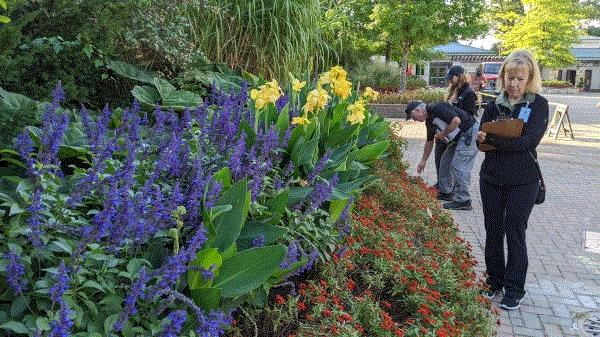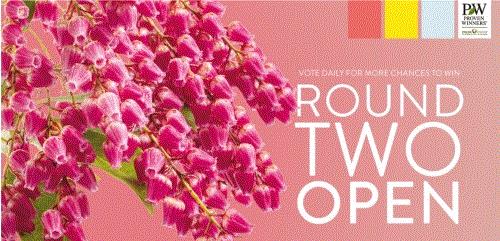Breeder Showcase at the Cincinnati Zoo & Botanical Gardens
Eason Horticultural Resources (EHR) and the Cincinnati Zoo have announced an interesting partnership that I’m sure will be welcome news for plant geeks out there.
As the zoo completes a large expansion to their plant trials, EHR has the pleasure of working alongside breeders and industry growers to fill the space with a diverse range of the latest plant genetics. There will be over 500 of the newest varieties on display from many breeders and well over 50,000 plants being grown for the trials. In total, this is being supported by over 25 companies that have helped to get the plants to the zoo for trialing.

The Cincinnati Zoo & Botanical Garden horticultural staff and volunteers have conducted plant trials throughout the gardens in the zoo for years, and more recently at the nearby Urban Learning Garden at Rockdale Academy. In conjunction with the debut of the first Breeder Showcase Day, a new trial garden will debut on the perimeter of the grounds. Trials include annuals, grasses and perennials in accordance with regimented protocols. Such trials enable the zoo to develop useful data for gardeners, other public gardens, plant producers and others in the green community.
The Breeder Showcase Day will take place August 30, 2023, and presents the opportunity to walk the trials and see how a variety of plants from various breeders performed over the summer. The gardens are open all season long.
If you’d like more information about the Breeder Showcase Day or would like to participate in future events, you can reach out to marketing@ehrnet.com.

PPA National Symposium
Speaking of events, the 2023 Perennial Plant Association (PPA) National Symposium is one that everyone should participate in at least once! The meeting will take place this year in Niagara Falls, Ontario, Canada, for a week designed to highlight the wonders of perennial plants.
From tours of public and private gardens to education crafted for diverse industry interests, this is THE event for perennial plant people. The National Symposium will be hosted at the Sheraton Fallsview in Niagara Falls, Ontario, from July 24-28, with tours exploring into the surrounding areas.
 Participants will have the opportunity to attend education, tours, socials, an evening garden dinner, plus a trade show, and can choose to participate in the weeklong experience (Monday-Friday) or a three-day Core Symposium (Tuesday-Wednesday).
Participants will have the opportunity to attend education, tours, socials, an evening garden dinner, plus a trade show, and can choose to participate in the weeklong experience (Monday-Friday) or a three-day Core Symposium (Tuesday-Wednesday).
Speaker highlights include:
-
Mark and Ben Cullen, Expert Garden Communicators
-
Gary Lewis of Phoenix Perennials
-
Dr. Allan Armitage, Renowned Horticulturist, Researcher and Speaker
-
Tony Spencer of The New Perennialist
-
Patrick Cullina of Patrick Cullina Horticultural Design and Consulting
Tour attractions include:
-
Niagara Parks Botanical Gardens & Butterfly Conservatory
-
Sheridan Nurseries
-
Terra Watertown
-
Kayanase Nursery and Ecological Restoration
-
Watering Can Flower Market
Plan on making lasting connections during evening visits and social events, which include the Royal Botanical Gardens’ Rock Garden for a special tour and dinner. PPA’s National Symposium follows traditions started over 30 years ago, but incorporates something new each year.
The early bird registration deadline is June 14, 2023 and final registration deadline is July 12, 2023. Go HERE for more information on the National Symposium and to register.

Morning Sun Cast Iron Plant
It’s always been a mystery to me why the genus aspidistra hasn’t gotten more recognition. Once established, it’s quite resilient and isn’t a preferred food source for deer. In talking with general gardeners, it seems a lot of people think of it as a tropical plant, which is definitely not true. Many species/cultivars are Zone 7b hardy with a few hardy to Zone 7a (minimum temp 0 to 5F). One of the more cold-hardy species is Aspidistra elatior, and within this genus, one of the more showy cultivars is Asahi (in the trade commonly called Rising Sun).

Photo courtesy of the J.C. Raulston Arboretum.
At about 2.5 ft. in height, the upper third of foliage has a white variegation that intensifies from emergence through the first fall (individual leaves persist two years before needing to be removed). It’s pretty striking in a shady environment, where the genus typically performs best. And if you’re north of Zone 7a, have no fear, as the genus as a whole translates well to being kept as a houseplant.

AmericanHort Plant Disease Webinar
Having an optimized collection of photos and information before reaching out for consultation on a plant problem is important in helping to diagnose an issue correctly and efficiently. Having this process in place will cut down on the time spent on the problem and avoid costly diagnostic mistakes.
AmericanHort is hosting a webinar called "Diagnosing Plant Problems" on April 4 from 2:00 to 3:30 p.m. Eastern that will help growers:
-
Build an information checklist to use when gathering information for accurate plant issue diagnosis
-
Learn what photographic subject matter is needed by the diagnostic expert you're working with and how to efficiently take those photos
-
Get a glimpse of the plant diagnostic process through the lens of a technical specialist to help with communication during the diagnosis process
This information can be applied whether working internally with a cultivation team or externally with cooperative extension personnel, product vendor representatives, or technical specialists. Register for this event here.

Shrub Madness Returns
The completion of this year's Shrub Madness competition will mark a decade of fierce shrub battles as players choose their favorite plants in the nation's favorite bracket competition for woody ornamentals.
In a thrilling single-elimination tournament, Shrub Madness pits 64 Proven Winners ColorChoice shrubs against one another to compete in a no-holds-barred battle to be crowned shrub champion.

With every top shrub historically being a rose or hydrangea, it remains to be seen if this year the public will break from tradition and vote a different genus to the top. Maybe Perfecto Mundo Double White Azalea will pull an upset or a quintessential quince like Double Take Scarlet will reign supreme? The voters will decide …
To cast votes during the plant matchups and be eligible for end-of-round random prize drawings, players can register for an account on the Shrub Madness website at any time until the last round of the competition.
From now until March 31, 2022, players can visit ShrubMadness.com to vote and send plants through to the next round of the competition. Registration is unnecessary to vote in the competition, but only those registered can win the plants and grand prize. A new account must be created each year to play.
I like an underdog, so my pick is Double Play Big Bang Spirea!

Darling 58 American Chestnut Update
In the January 24 edition of Nursery & Landscape Insider, I mentioned that APHIS (Animal & Plant Health Inspection Service) was gathering public comments on the possible deregulation (and hence release to the public) of a transgenic American chestnut cultivar, Darling 58. Since then, I've gotten lots of questions that have focused on—what next?
Well, first I can say that the 17,500-plus public comments on this seem to be mostly in favor of accepting the petition to deregulate Darling 58. But that’s just one step in a longer process. IF it is deregulated (because there's still uncertainty about that), pollen from Darling 58 will be used to create orchards that will after about seven years produce the seed that will then be germinated. After a year, bareroot seedlings could be distributed.
So, assuming the petition to deregulate happens this year, the original crosses would happen in 2024, those seed germinated in 2025, then add seven years of waiting for those seeds to reach maturity and produce seed, followed by a couple of years to develop the seedlings that will be distributed to the public. That’s 2034-35, folks. Quite a wait, but better than nothing, right?

Our Wacky Wonderful World—Notes from the Edge of Sanity 1.0
Many of you let me know that the last newsletter mysteriously was void of my typical rant! Well, have no fear, as we’ll catch up today. Here’s the Notes from the Edge of Sanity that should have run in the last newsletter …
As we look back on Black History Month, I would like to give some attention to a man whom I have a tremendous amount of respect for—George Washington Carver. Many people credit him with making significant strides that led to the adoption of sustainable farming practices across the southern/southeastern U.S. Others credit him with advances in specialty crop agriculture, such as the promotion of peanuts and sweet potatoes.
All of these (and more) are true. I personally recognize him as a pioneer in the native plants movement. There’s not a great deal of fanfare related to this topic, but Professor Carver (Tuskegee Institute) did pen one of the first university extension publications on native plants in the south, titled "Some Ornamental Plants of Macon Co., Alabama." The publication highlighted the tremendous diversity of plants in the Flint River basin of Alabama. Later he wrote, "Nature’s Garden for Victory & Peace," which focused on culinary and medicinal uses of many so-called “weeds” (i.e. native plants in the wrong place).
More than anything, what impresses me about George Washington Carver was the diversity of his work. In today’s world of specialization (particularly in academia), value is placed on being an expert in something. Along the way, we’ve lost the ability to integrate ideas from widely differing crops and agricultural systems, and as a result, many of us fail to see the diversity of the natural (and manmade) world around us. It’s ironic because many of us (myself included, sometimes) fail to see the diversity in people that makes this big ol’ goofy world so wonderful. What made George Washington Carver so unique wasn’t necessarily that he was smarter than the next person, but rather he was willing to push the boundaries for the betterment of society.
As we look back on Black History Month, we should reflect on this and ask: Are we willing to do the same?

Our Wacky Wonderful World—Notes from the Edge of Sanity 2.0
Now, I'm back on schedule!
A couple of things to set this up. First, did you know March is Women’s History Month? Second, did you know that, on average, women earn 84% of men for the same position?
That leads us to a little-known date on the calendar—Equal Pay Day. This date is associated with the fact that women working full time, year round, are paid 84 cents and all earners (including part time and seasonal) are paid 77 cents for every dollar paid to men. This year, it landed on March 14.
This is a problem, folks. Particularly considering the fact that it’s 2023, and from my perspective, women are just as equipped as men to do any job in our industry. Maybe it’s time we as an industry address this issue (and don’t believe for a hot second it isn’t an issue) both in public and private sector horticultural positions.
Furthermore, if ya want even more depressing numbers, check out these wage discrepancies.
-
Black women (full time) are paid 67 cents and all black women (including part time and seasonal) are paid 64 cents for every dollar compared to non-Hispanic white men.
-
Moms (full time) are paid 74 cents and all moms (including part time and seasonal) are paid 62 cents for every dollar paid to dads.
-
Latina women (full time) are paid 57 cents and all Latina earners (including part time and seasonal) are paid 54 cents for every dollar paid to non-Hispanic white men.
I’d love to hear from you managers and business owners out there that have taken efforts to mitigate the pay gap—along with what prompted you to act!




Live authentic,

Matthew Chappell
Editor-at-Large
Nursery & Landscape Insider
This has been received by 32,272 of the hardest-working horticulturists in show business!
If you're interested in reaching 32,272 clients who eagerly await every Nursery & Landscape Insider and surely read every word, contact Kim Brown ASAP and she'll hook you up.